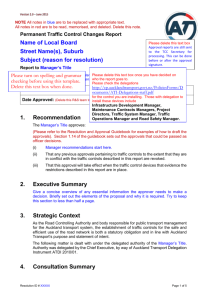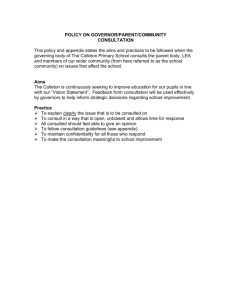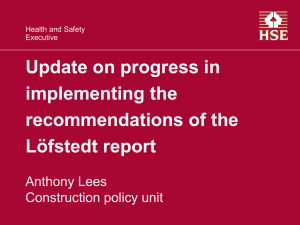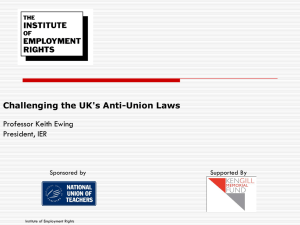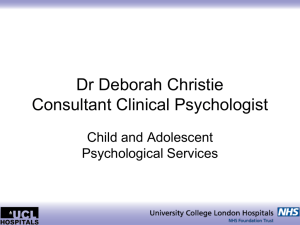Permanent Traffic and Parking Changes Report Version 2.0
advertisement
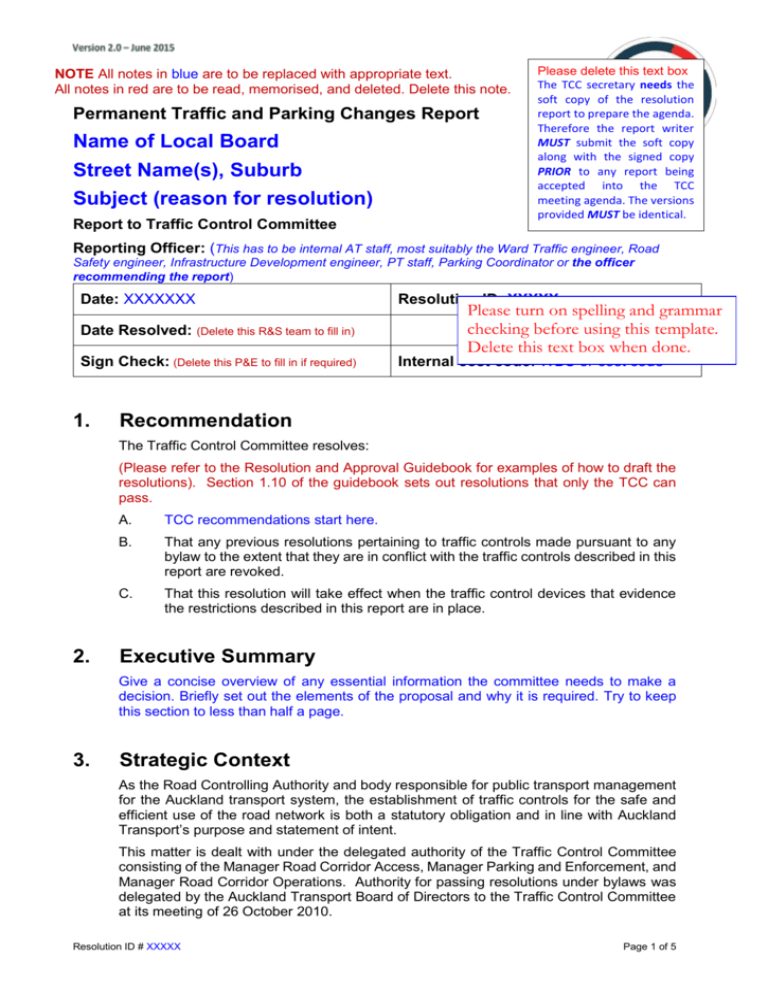
NOTE All notes in blue are to be replaced with appropriate text. All notes in red are to be read, memorised, and deleted. Delete this note. Permanent Traffic and Parking Changes Report Name of Local Board Street Name(s), Suburb Subject (reason for resolution) Report to Traffic Control Committee Please delete this text box The TCC secretary needs the soft copy of the resolution report to prepare the agenda. Therefore the report writer MUST submit the soft copy along with the signed copy PRIOR to any report being accepted into the TCC meeting agenda. The versions provided MUST be identical. Reporting Officer: (This has to be internal AT staff, most suitably the Ward Traffic engineer, Road Safety engineer, Infrastructure Development engineer, PT staff, Parking Coordinator or the officer recommending the report) Date: XXXXXXX Date Resolved: (Delete this R&S team to fill in) Sign Check: (Delete this P&E to fill in if required) 1. Resolution ID: XXXXX Please turn on spelling and grammar checking before using this template. Delete this text box when done. Internal cost code: WBS or cost code Recommendation The Traffic Control Committee resolves: (Please refer to the Resolution and Approval Guidebook for examples of how to draft the resolutions). Section 1.10 of the guidebook sets out resolutions that only the TCC can pass. 2. A. TCC recommendations start here. B. That any previous resolutions pertaining to traffic controls made pursuant to any bylaw to the extent that they are in conflict with the traffic controls described in this report are revoked. C. That this resolution will take effect when the traffic control devices that evidence the restrictions described in this report are in place. Executive Summary Give a concise overview of any essential information the committee needs to make a decision. Briefly set out the elements of the proposal and why it is required. Try to keep this section to less than half a page. 3. Strategic Context As the Road Controlling Authority and body responsible for public transport management for the Auckland transport system, the establishment of traffic controls for the safe and efficient use of the road network is both a statutory obligation and in line with Auckland Transport’s purpose and statement of intent. This matter is dealt with under the delegated authority of the Traffic Control Committee consisting of the Manager Road Corridor Access, Manager Parking and Enforcement, and Manager Road Corridor Operations. Authority for passing resolutions under bylaws was delegated by the Auckland Transport Board of Directors to the Traffic Control Committee at its meeting of 26 October 2010. Resolution ID # XXXXX Page 1 of 5 4. Consultation Summary Summarise any main themes or issues from the consultation and how these were responded to. A fuller description of the consultation of who was consulted, the methodology and a more detailed review of the feedback and how this was responded to is set out in the consultation section of the appendix. 5. Signatures and Approvals (Explanatory Note: The author of any report is responsible for tracking the report and getting the signatures. The signatures should be obtained in the order shown below.) Name and title of signatory Consultant/Author: Signature Date Remove this row if the report has been drafted in house. Recommended by: (Name) Position Division - Department (person responsible for engaging the author) Verified by: Anthony Herath Senior Resolution Technician Transport Controls Approved by: (Name) Traffic Operations Team Leader (By area) by Public Transport, then add Brendon Main (Bus If the project is initiated Network Operations Services Manager, Bus Services) toand the Safety list of Approved by signatories. The Approved by: Rick Bidgood report is sent to Andrew Maule for review. Parking Enforcement Manager Parking Enforcement Resolved by: Signature Name Date Resolved Traffic Control Committee ………………………… Chairperson Traffic Control Committee Resolution ID # XXXXX Page 2 of 5 Appendix 6. Background 6.1 How the matter arose Describe what has brought the road / area to Auckland Transport’s attention. Public request/comment, resource consent, significant issues i.e. crashes, complaints/queries, internal review, etc. 6.2 Location This section of road is classified as a District Arterial / Regional Arterial / Collector / Local Road (use appropriate and delete others) and is situated between (insert appropriate) Street Name and (insert appropriate) Street Name in the (insert appropriate) Local Board area. This road / Street Name is in a predominantly commercial / industrial / retail / residential Describe the road location i.e. if the road is a cul-de-sac this must be stated in the report, if the width of the road is an issue then the width of the carriage way must be stated (and shown on the drawing), if the lane layout is being amended the new lane widths must be stated (and shown on the drawing). See section 2.10.4.2 in the resolution guidebook for any other pertinent information that should be included in this section. AADT should be documented in the report if it is obtainable. It is acceptable to use engineering judgement to estimate the AADT. If the road is within a parking zone this should be stated. 7. Issues and Options 7.1 Proposal It is proposed to (briefly outline your proposal) as shown on the attached drawing(s) # XXXXX, Rev X dated XX/XX/XXXX. (If there are nearby traffic controls that do not appeared to be covered by a resolution and were in operation for a period before the creation of AT, include a brief statement to this effect. If the existing restrictions are reasonable and appropriate then capture them in this resolution. But if you find the existing traffic controls needs to be changed or rescinded then follow the normal resolution procedure with consultation to make the appropriate changes.) 7.2 Alternatives Include a Do Nothing option. Explain in an analytic manner the alternate solutions that were considered besides the proposal as a solution to the issue and why those were not chosen. For example if you are proposing No Stopping At All Times (NSAAT) restrictions for an issue then explain why it is more suitable than other parking restrictions such as (No Stopping At Certain Hours (NSACH), time restricted parking, or clearway, etc. 7.3 Local Board Transport spokesperson (if appropriate) The Local Board is contacted via the Elected Member Relationship Team. You need to state whether the Local Board was consulted, who responded to the consultation—Board Resolution ID # XXXXX Page 3 of 5 member(s) or the transport spokesperson? Did the Local Board support, object to, or make no comment on the proposal? If the Local Board makes no comment on the proposal this should be described in the report as being that “the Local Board raised no objection to the proposal.” Any options the Local Board suggest are evaluated in section 7.2 Alternatives. If the Local Board has any specific comments (particularly where they have concerns) on the proposal, you will need to work with the EMRM to see if the issues can be resolved. If you are unable to satisfactorily resolve the concerns of the Local Board you will need to be very clear in section 7.5 Analysis why you are advising that AT continues with the proposal. Explanatory Note: Consultation is required with Local Boards in all cases except possibly urgent safety situations and resolutions for controls that have been in place and operating since before the creation of Auckland Transport. (Please delete) 7.4 Consultation Consultation on the proposal was undertaken with the following internal parties If any road in the proposal Finance (setting fees and charges) Clickishere to choose identified as an Parking Enforcement Clickoverdimensional here to choose or Parking Design and Policy Clickoverweight here to choose route, you Public Transport Clickmust here contact to choose Chris Community and Road Safety ClickGlanfield here to choose in RCA. He will Traffic Operations Clickadvise here toyou choose on the Walking & Cycling Clickprocedure here to choose for consulting ATOC Clickon here choose ODtoand OW routes. Road Corridor Access Click here to choose Delete this box. If a party is not consulted, give the explanation why it was not required. Consultation with Public Transport is required on all proposals. Consultation is to be sent to the following email address: MetroBusFeedback@aucklandtransport.govt.nz – delete this box when the consultation is finished. Describe the nature of the consultation – emails, team presentations, face to face meetings etc. Analysis of the feedback does not go here; it’s properly done in the Analysis section. Consultation on the proposal was undertaken with the following external parties Affected residents/property owners Affected businesses Affected road users (where impact extends beyond immediate area) Affected community groups Public transport operators Emergency services Business association Police Click here to choose Click here to choose Click here to choose Click here to choose Click here to choose Click here to choose Click here to choose Click here to choose (If a party is not consulted, give the explanation why it was not required) Set out what affected business or community groups were consulted (i.e. Heart of the City, Cycle Action Auckland, etc.). Consult road users in situations where the users most affected cannot be easily identified (i.e. bus lane, off street car parks etc.). Describe the Resolution ID # XXXXX Page 4 of 5 nature of the consultation – letters, public meetings, site meetings, face to face meetings, onsite signs, website, etc. Include the numbers of letters sent out and numbers of responses received. Also include the number of responses in support of, opposed to, and had no comment on the proposal. Analysis of the feedback does not go here; it’s properly done in the Analysis section. 7.5 Analysis This is where you analyse any consultation feedback as well as the proposal. Set out any themes from the consultation responses and any changes made to the proposal as a result of them. Explain any objections and your responses to the objections (be brief). It is expected that there will always be a close out to any consultation where feedback was received explaining what has been changed or why changes have not been made. Describe how your response was communicated back to the respondent(s) to discuss their points? Were there any further comments after your response(s) were communicated back to them? It should be clear what your professional opinion is (supported by your technical evidence) to defend the implementation of the proposal. Explain your reasoning if it isn’t clear why your proposal is favoured if there is negative consultation feedback – particularly if the opposition is from the Local Board. A road safety audit will often be appropriate. Note the conclusions from a safety audit if undertaken or explain why a road safety audit was not considered necessary in this case. Resolution ID # XXXXX Page 5 of 5
